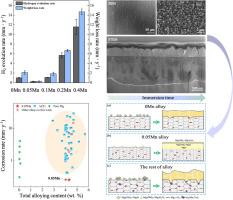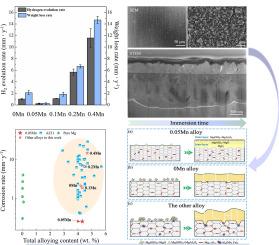锰含量对高纯镁制备AZ31镁合金耐蚀性的影响
IF 9.3
1区 材料科学
Q1 MATERIALS SCIENCE, MULTIDISCIPLINARY
引用次数: 0
摘要
AZ31镁合金的广泛应用受到其不稳定和通常较差的腐蚀的严重限制。锰(Mn)通常添加到AZ31合金中,以减轻杂质元素,特别是铁(Fe)的不利影响。它的功效主要取决于铁/锰比,而铁/锰比随成分和工艺的不同而变化。虽然国际标准规定了允许的Mn含量,但AZ31合金的最佳Fe/Mn比仍不清楚,特别是当使用高纯度Mg原料制造时。这样的AZ31合金本身具有低杂质水平,并且已经表现出更好的耐腐蚀性,这是对Mn添加的必要性和最佳含量的重新评估。在这里,我们系统地研究了Mn (0-0.4 wt.%)含量(在现行标准范围内)对由高纯度Mg制成的AZ31合金的耐腐蚀性的影响。结果表明,当铁锰比为0.0075时,合金的腐蚀速率较低(PW = ,在3.5 wt.% NaCl溶液中,PW = 0.25 mm·y-1),与高纯度Mg合金的腐蚀速率相当。这种性能的增强是由于促进了均匀腐蚀和形成致密的双层保护膜(外层:Mg(OH)2+尖晶石,内部:MgO),有效地抑制了进一步的腐蚀进展。这些发现不仅为设计高质量的镁合金,特别是高耐腐蚀的Mg- al合金提供了重要的指导,而且强调了在使用高纯度Mg时修改合金标准的必要性。本文章由计算机程序翻译,如有差异,请以英文原文为准。


Effect of manganese content on the corrosion resistance of AZ31 Mg alloys fabricated from high-purity magnesium
The widespread application of AZ31 magnesium (Mg) alloys is severely limited by their inconsistent and often poor corrosion. Manganese (Mn) is routinely added to AZ31 alloys to mitigate the adverse effects of impurity elements, particularly iron (Fe). Its efficacy depends critically on the Fe/Mn ratio, which varies with both composition and processing. Although international standards specify the allowable Mn content, the optimal Fe/Mn ratio for AZ31 alloy remains unclear, especially when fabricated from high-purity Mg feedstock. Such AZ31 alloys inherently possess low impurity levels and already exhibit improved corrosion resistance, warranting a re-evaluation of both the necessity and optimal content of Mn addition. Here, we systematically investigate the impact of Mn (0–0.4 wt.%) content —within the bounds of current standards—on the corrosion resistance of AZ31 alloys derived from high-purity Mg, and identify a critical Fe/Mn ratio of 0.0075 yields the most pronounced improvement. The resultant AZ31–0.05Mn alloy achieves a low corrosion rate (PW=0.25 mm·y-1, in 3.5 wt.% NaCl solution), comparable to that of high-purity Mg. This performance enhancement is attributed to the promotion of uniform corrosion and formation of a compact double-layer protective film (the outer: Mg(OH)2+spinel and inner: MgO), effectively suppressing further corrosion progression. These findings not only offer crucial guidance for designing high-quality Mg alloys, particularly high corrosion-resistant Mg-Al alloys, but also underscore the need to revise alloy standards when high-purity Mg is employed.
求助全文
通过发布文献求助,成功后即可免费获取论文全文。
去求助
来源期刊

Acta Materialia
工程技术-材料科学:综合
CiteScore
16.10
自引率
8.50%
发文量
801
审稿时长
53 days
期刊介绍:
Acta Materialia serves as a platform for publishing full-length, original papers and commissioned overviews that contribute to a profound understanding of the correlation between the processing, structure, and properties of inorganic materials. The journal seeks papers with high impact potential or those that significantly propel the field forward. The scope includes the atomic and molecular arrangements, chemical and electronic structures, and microstructure of materials, focusing on their mechanical or functional behavior across all length scales, including nanostructures.
 求助内容:
求助内容: 应助结果提醒方式:
应助结果提醒方式:


